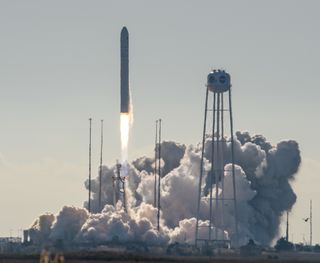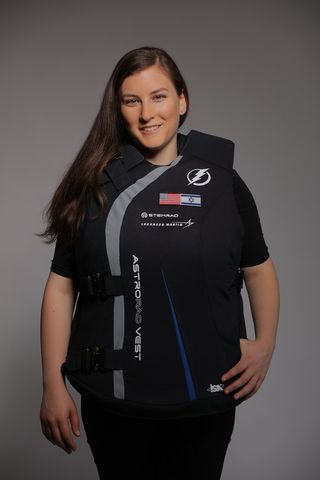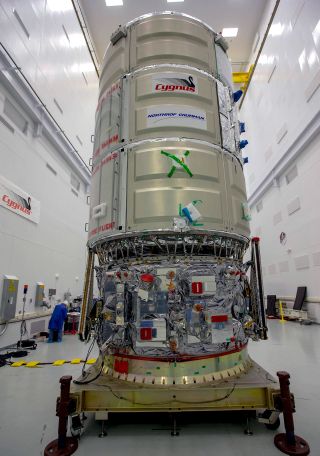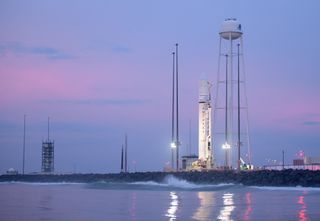WALLOPS ISLAND, Va. — A space cookie oven launched with rodents to space today (Nov. 2) aboard the most powerful Antares rocket ever built.
At 9:59 a.m. EDT (1359 GMT) this morning, the Cygnus NG-12 spacecraft successfully launched to the International Space Station from Virginia Space's Mid-Atlantic Regional Spaceport at NASA's Wallops Flight Facility. The launch carried about 8,200 lbs. (3,700 kilograms) of scientific experiments, hardware and supplies to the space station, where it will arrive on Monday (Nov. 4) to be grappled by NASA astronaut Jessica Meir who will be supported by fellow astronaut Christina Koch.
With nearly perfect weather, including brilliant blue skies and comfortably crisp air, the launch went off without a hitch. "This never gets trivial ... the people that I work with day in and day out are all excited and look forward to this every time we get to do this," Kirk Shireman, the deputy manager of the space station, said during a pre-launch press conference. This was the first launch as part of the second phase of the Commercial Resupply Services (CRS) flights. NASA awarded the contract for this second phase in 2016.
Video: Blastoff! Cygnus NG-12 Mission Launches To Space Station
Related: In Photos: Antares Rocket Launches Cygnus NG-12 Cargo Craft

The Cygnus NG-12 cargo spacecraft launched aboard an Antares 230+ rocket at 9:59 a.m. EDT on Saturday morning on Nov. 2, 2019.
(Image credit: Bill Ingalls/NASA)
Weird science
Aboard the Cygnus spacecraft is both equipment to support and sustain existing experiments on the space station as well as new investigations that will be introduced to the six astronauts currently on station.
Of the new investigations headed to space, there are a few that have particularly caught the public's attention.
One of these experiments will bring the smell of fresh-baked cookies to the space station. A joint collaboration between Zero G Kitchen and NanoRacks has developed and built the first-ever oven designed to work in the microgravity environment on the space station. The astronauts on the station will conduct the first experiment with the oven by baking chocolate chip cookies. While food on the space station now is primarily reheated or heated with the addition of hot water, this will be the first instance of baking in space.
Another investigation, Microgravity as a Disruptor Of The 12-hour Circatidal Clock (Rodent Research-14) will use rodent models to study how phases of light and dark can affect liver health.

The AstroRad vest.
(Image credit: The Israel Space Agency)
The AstroRad vest, another investigation that launched today, is a large, unique vest designed to protect astronauts during points of extreme radiation in space.
"This is the first mission of AstroRad, the next will be on Artemis 1 around the moon," Oren Milstein, the founder of StemRad, an Israeli-American start-up that makes the AstroRad vest, said during a pre-launch science briefing on Nov. 1. Milstein continued, describing how the specialized vest is designed so that it provides extra protection to vital organs and areas of the body especially vulnerable to radiation. Milstein added that they are taking gender into account when designing the vest to protect a variety of people.
The vest is also designed with the intention to additionally protect people on Earth working in environments with, for instance, nuclear radiation exposure.
Technical improvements
Once the Cygnus craft reached the space station on Monday, there will be two Cygnus spacecraft in orbit around Earth for the first time ever. The Cygnus NG-11 spacecraft, which launched from Wallops Flight Facility on April 17, 2019, and, after departing from the space station in August (marking the longest time a Cygnus spacecraft has spent at the station), the craft is in the second phase of its mission, still in orbit.
While this will be the first time there will be two Cygnus spacecraft in orbit, "We don’t foresee any issues," Frank DeMauro, the vice president and general manager of space systems at Northrop Grumman said during the pre-launch conference. "We've done a lot of testing," he added, explaining how, with the Cygnus NG-12 still on Earth, ground teams have prepared to be able to handle both at the same time.
Not only will this craft be making history by doubling the number of Cygnus spacecraft in orbit, but the craft has also been improved alongside the Antares rocket, which is now the Antares 230+ rocket, the most powerful Antares rocket ever built.
As Pete Hasbrook, manager of International Space Station Program Science Office, explained during the science briefing, the vehicles have increased mass and volume capacity for cargo; more powered lockers, which are cargo container that can power elements like heat and cooling from launch to deliver at the space station; telemetry for the experiments, in other words, scientists can access data from their experiments from launch to arrival at the station and the ability to dispose external instruments and payloads.
A part of history

The Cygnus NG-12 spacecraft was christened the "S.S. Alan Bean" in honor of the Apollo 12 astronaut.
(Image credit: Northrop Grumman)
The Cygnus spacecraft that launched today was named the SS Alan Bean after NASA astronaut (and artist) Alan Bean who, just about fifty years ago at the time of this launch, launched to the moon with NASA's Apollo 12 mission and became the fourth person to ever walk on the lunar surface. Bean also commanded the second Skylab crew and remained a vital part of human spaceflight until he passed away at the age of 86 in 2018.
This launch will do more than just honor the history and legacy of Alan Bean, it is also a reminder that very soon, this upcoming year, it will be the 20th year that there has been a human presence in space with the International Space Station. For those born after the year 2000 (roughly a quarter of the entire world's population), they have never lived without humans in space.
"Here we sit 19 years later and every day of every year we've had people living and working in space," Shireman said. He continued, adding that the station "still has a lot of life in it so I’m excited about the years we have left."

Northrop Grumman's Antares rocket stands on launch Pad-0A on Wednesday, Oct. 30, 2019 at NASA's Wallops Flight Facility in Virginia.
(Image credit: NASA/Bill Ingalls)
Follow Chelsea Gohd on Twitter @chelsea_gohd. Follow us on Twitter @Spacedotcom and on Facebook.
https://www.space.com/cygnus-ng-12-antares-nov-2-wallops-launch.html
2019-11-02 14:37:00Z
52780424965037
Tidak ada komentar:
Posting Komentar